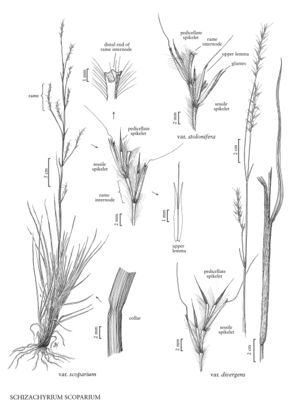Difference between revisions of "Schizachyrium scoparium var. stoloniferum"
FNA>Volume Importer |
imported>Volume Importer |
||
| (4 intermediate revisions by 2 users not shown) | |||
| Line 17: | Line 17: | ||
-->{{Treatment/Body | -->{{Treatment/Body | ||
|distribution=Miss.;Fla.;Ala.;Ga.;N.C.;S.C. | |distribution=Miss.;Fla.;Ala.;Ga.;N.C.;S.C. | ||
| − | |discussion=<p>Schizachyrium scoparium var. stoloniferum grows in sandy soils of woodland openings and roadsides from southern Alabama and Georgia south to the Everglades. Northern populations consist of widely spaced, weak culms growing in rather bare sand; southern populations consist of dense, vigorous stands with taller, more robust culms growing primarily along roadsides, possibly spread by grading equipment. Some clones, particularly in the south, are largely sterile.</p> | + | |discussion=<p><i>Schizachyrium scoparium </i>var.<i> stoloniferum</i> grows in sandy soils of woodland openings and roadsides from southern Alabama and Georgia south to the Everglades. Northern populations consist of widely spaced, weak culms growing in rather bare sand; southern populations consist of dense, vigorous stands with taller, more robust culms growing primarily along roadsides, possibly spread by grading equipment. Some clones, particularly in the south, are largely sterile.</p> |
|tables= | |tables= | ||
|references= | |references= | ||
| Line 26: | Line 26: | ||
-->{{#Taxon: | -->{{#Taxon: | ||
name=Schizachyrium scoparium var. stoloniferum | name=Schizachyrium scoparium var. stoloniferum | ||
| − | |||
|authority=(Nash) | |authority=(Nash) | ||
|rank=variety | |rank=variety | ||
| Line 34: | Line 33: | ||
|family=Poaceae | |family=Poaceae | ||
|illustrator=Linda A. Vorobik | |illustrator=Linda A. Vorobik | ||
| + | |illustration copyright=Utah State University | ||
|distribution=Miss.;Fla.;Ala.;Ga.;N.C.;S.C. | |distribution=Miss.;Fla.;Ala.;Ga.;N.C.;S.C. | ||
|reference=None | |reference=None | ||
| Line 39: | Line 39: | ||
|publication year= | |publication year= | ||
|special status= | |special status= | ||
| − | |source xml=https:// | + | |source xml=https://bitbucket.org/aafc-mbb/fna-data-curation/src/200273ad09963decb8fc72550212de541d86569d/coarse_grained_fna_xml/V25/V25_1614.xml |
|subfamily=Poaceae subfam. Panicoideae | |subfamily=Poaceae subfam. Panicoideae | ||
|tribe=Poaceae tribe Andropogoneae | |tribe=Poaceae tribe Andropogoneae | ||
Latest revision as of 17:57, 11 May 2021
Plants not cespitose, with long, scaly rhizomes. Culms 58-210 cm. Sheaths usually pubescent near the collars; blades 10-39 cm long, 3.5-9 mm wide, pubescent near the collars. Rames 2-6.5 cm, with 6-14 spikelets, usually partially to fully exserted; internodes pubescent, hairs to 4.5 mm. Sessile spikelets 5-10 mm; calluses with hairs to 2.5 mm; awns 6-14 mm. Pedicels 3.5-5 mm, curving out at maturity. Pedicellate spikelets 0.75-4 mm, sterile, awned, awns 1-3 mm.
Distribution
Miss., Fla., Ala., Ga., N.C., S.C.
Discussion
Schizachyrium scoparium var. stoloniferum grows in sandy soils of woodland openings and roadsides from southern Alabama and Georgia south to the Everglades. Northern populations consist of widely spaced, weak culms growing in rather bare sand; southern populations consist of dense, vigorous stands with taller, more robust culms growing primarily along roadsides, possibly spread by grading equipment. Some clones, particularly in the south, are largely sterile.
Selected References
None.
